Whatever your favorite romance trope, the Romance Beat Sheet in Plottr helps you guide readers from a strong hook to a happily ever after (or “happily for now”). Here’s how to craft better romances.
What is the Romance Beat Sheet Plot Structure?
The Romance Beat Sheet is the brainchild of paranormal romance author Jami Gold. It combines key beats from Blake Snyder’s Save the Cat and Larry Brooks’s Story Engineering, mixed with character arc elements from Michael Hauge’s plot structure.
Here’s how this beat sheet can help you:
3 Ways the Romance Beat Sheet Template Will Help You
Romance readers are voracious but they expect specific beats, depending on your subgenre. Besides helping you give readers what they want, the Romance Beat Sheet will help you:
Create Strong Opening Images and Hooks to Draw Readers In
The first beat in this plot structure is the opening image, a hook that introduces your leads’ ordinary world.
This is where you start to build empathy in your readers, by showing your characters human flaws, desires, positive traits and lack.
This beat helps you to make your characters feel real and relatable, right from the start
Build Romantic Tension through Obstacles and Conflict
Think of great love stories, from Jane Austen’s Pride and Prejudice to contemporary paranormal romance.
In most romances, love takes its time, and the road toward romantic union is full of setbacks.
Several beats in the Romance Beat Sheet remind you to create tension and denial of desire. For example:
- The Inciting Incident: In Plottr’s template, guidelines for this beat remind you to create conflict such as clashing perspectives or values between romantic leads
- Pinch Points: Moments that show oppositions between characters’ inner and outer conflicts. These put added strain on the early stages of romantic connection
Create Crises that Raise Stakes and Resolutions that Bring Relief
Great romances create a real sense of romantic tension and chemistry. One ingredient for this effect is creating (and raising) the stakes.
The Romance Beat Sheet includes beats for crisis points that make (re)union seem almost impossible.
Curious to know what the nine beats of the Romance Beat Sheet are? Keep reading.
Explore the Romance Beat Sheet Template in Plottr
Here are the nine beats of the Romance Beat Sheet. See examples from NYT bestselling author Colleen Hoover’s It Starts with Us from 2022 [warning: spoilers ahead!]:
Act 1
Opening Image/Hook
The hook introduces the protagonists. It grabs the reader’s attention and draws them into the story, while setting up the romance conflict.
- Introduce the protagonist(s) by showing them in their everyday life and offer a glimpse at the internal struggle that is holding them back from love
- Create empathy for the protagonist(s) – demonstrate their desires, flaws, positive traits, and something they lack
- Foreshadow the coming conflict that will challenge any potential romance with a collision between external goal and internal goal (e.g. the protagonist is succeeding in their career and is expecting an upcoming promotion that may take up all of their time)
Example: Atlas Corrigan, Lily Bloom’s first love, arrives at his restaurant to discover evidence of a break-in. He has empathy for the possible perpetrator, as the act reminds him of his own difficult past. He shakes off his co-workers’ prying questions about bumping into Lily by chance in the street, as he doesn’t want to make the blast from the past bigger than it is.
Meanwhile, Lily found their encounter unnerving, too. She worries about her appearance or having said the wrong thing. She also worries her abusive ex-husband Ryle would have an issue with her reconnecting with Atlas because they had fights about him in the past.
Inciting Incident
Through external forces, chance or a life event, the protagonists meet for a first (or subsequent time if they are old flames or have some prior connection).
Readers should be able to glimpse here that the protagonists could be right for one another romantically, given time…
- Pick an Inciting Incident that brings the protagonists together (e.g. a vacation, new job, family introduction, or a stressful moment like severe weather or natural disaster)
- Create conflict between the protagonists (e.g. different life perspectives, different values, personality clashes, or an external obstacle like a disapproving family)
- Demonstrate how right the Protagonists could be right for each other and why/how they are not ready
Example: Atlas and Lily’s chance meeting reignites old emotions and sets their romance in motion, despite the challenges and doubts in their current lives.
End of Beginning
An event or a situation brings the protagonists together and forces them to spend time cooperating to achieve a goal.
This event raises the tension and stakes and allows for a clear definition of each of the protagonist’s goals. While still at odds with each other, sparks are starting to fly.
Pay attention to both the external (outside forces that impact the relationship) and internal (beliefs, desires, fears) aspects that impact your protagonists.
Example: After their chance encounter, Atlas visits Lily at her flower shop. Atlas brings her lunch, hoping to reconnect, but their meeting is interrupted when Lily’s ex-husband, Ryle, shows up unexpectedly.
Lily hides Atlas in a closet to avoid conflict. He pulls her into the closet to talk when she goes to free him. The tension between Atlas and Lily rises as they both navigate their complicated feelings for each other. Atlas asks whether he can call her that evening and she agrees.
Act 2
Pinch Point 1
The protagonists are starting to admit to their feelings for each other and may even begin considering a relationship.
Enter Pinch Point 1: the reader is granted a first glimpse at the opposition or conflict between the protagonist’s inner and outer conflict.
Each protagonist is still working toward their own goals, but the growing relationship begins to create conflict, raising the tension.
- What events occur in Pinch Point 1? The protagonists may share a kiss, an intimate moment, a fun moment, or have feelings grow due to watching the other be selfless, trustworthy, or capable of achieving a goal
- How does the Pinch Point affect their relationship?
Example: Atlas and Lily start to open up about their pasts, sharing intimate moments during phone calls and on a quiet dinner date.
Though their feelings are growing, they agree to take things slow due to Lily’s complicated situation with Ryle.
Atlas’s protective side emerges when he learns that Ryle’s jealousy led to past abuse. This realization raises the emotional stakes as Atlas’s desire to protect Lily conflicts with her fear of how Ryle will react to their budding romance, creating internal and external tension.
with a Free Plottr Trial
Midpoint
The tension continues to rise as another new development raises the stakes.
This section sets the protagonists on a false victory or false defeat. In a false victory, it appears as though the protagonists will commit to each other. A false defeat will give the impression they will never find a way to be together.
Example: After a romantic evening where they share their first kiss since their teenage years, Lily and Atlas seem ready to commit to each other. However, when Ryle unexpectedly confronts Lily in a fit of jealousy and violence, the situation feels dire.
Atlas reassures Lily with his support, but the tension between her fear of Ryle and her desire to move forward with Atlas creates a sense of false defeat. The possibility of happiness seems distant as Lily contemplates the risks of continuing their relationship.
Pinch Point 2
Pinch Point 2 gives another glance at the inner conflict of the protagonists.
Their intimacy and relationship are continuing to grow, but inner struggles and doubts begin to resurface. These are the inner conflicts that must be resolved before either person can commit.
Example: As Lily and Atlas’s relationship deepens, doubts begin to resurface. Lily struggles with her lingering fear of Ryle’s potential reaction and her guilt about how their relationship might affect their daughter, Emerson.
Atlas, while growing closer to Lily, also faces his own uncertainties about raising his half-brother Josh (who it turns out was the one vandalizing his restaurants) and his past with his estranged mother.
These inner conflicts cast a shadow over Atlas and Lily’s happiness, forcing both to question whether they can fully commit to each other without resolving their emotional baggage.
Crisis
This beat raises the stakes to their highest level yet, bringing a low for the protagonist(s) and their relationship.
An event or betrayal occurs which breaks the bond of trust, and the protagonist falls back into their fear or false beliefs from before as they see them manifest before them.
This often leads to a breakdown of the relationship and gives the reader the impression the romantic leads will never be together.
- External: What event or betrayal triggers the characters’ fear about their relationship, forcing them back into their false beliefs? (e.g. one character chooses their external goals over their internal, like accepting a job in another city)
- Internal: How do the characters realize the relationship is over? This is often a confirmation of doubts or false beliefs. (e.g. they knew the other cannot be trusted, and this event proves it)
Example: Lily’s relationship with Atlas is thrown into turmoil when Ryle confronts her about their relationship, physically threatening her in a fit of jealousy.
Lily is terrified, realizing that her fear of Ryle’s anger is still controlling her life, leading her to question whether she can continue seeing Atlas.
Despite Atlas’s support, Lily retreats into her false belief that being with Atlas could harm her daughter, leaving her uncertain about their future together and fearing that they can never fully be happy.
Act 3
Climax
Both of the protagonists must decide whether they will succumb to their false beliefs or work through their inner conflicts to save the relationship.
They work to fix the internal and external problems and learn the lesson which brings them to their transformation. The reader finds out whether the protagonists will end up together.
- External: What inner conflicts continue to threaten the relationship? These are the conflicts that must be addressed and solved
- Internal: How do the protagonists prove they want to continue in a relationship together? This can be refusing the job, choosing to trust, or having a conversation to clear up misconceptions
- Forgiveness is often a theme. Resolve the conflict of internal and external desires and show how the protagonists have transformed
Example: Lily, after another violent encounter with Ryle, realizes she cannot let her fear of him control her life or her relationship with Atlas.
With the support of Ryle’s sister Allysa and her husband Marshall, Lily confronts Ryle and insists he gets anger management therapy, allowing her to reclaim her independence.
Meanwhile, Atlas, determined to protect both Lily and his brother Josh, commits fully to building a life with Lily. By choosing to face their fears and prioritizing their love, Lily and Atlas work through their inner conflicts and agree to move in together.
Resolution
The protagonists are now together and moving into their happily ever after that readers have been waiting for.
They are now fully committed. (Unless it is a “happily for now” ending.)
- Show how the protagonists have changed over the course of the story and how they now interact with each other and their ordinary world
- They must be in an opposite state from the beginning
- Allow the protagonists a moment of enjoyment and celebration – they have earned it
- If part of a series, consider leaving a hook for the next installment
Example: Lily and Atlas have fully committed to each other. Lily no longer fears Ryle, as she has established boundaries for his involvement with their daughter.
Atlas, now a stable presence for both Lily and his brother Josh, feels whole and fulfilled. They enjoy the simple joy of everyday life, celebrating their love and newfound family.
The story ends with their wedding, where Atlas reflects on their journey, feeling hopeful for their future together. They have both transformed and found happiness.
And there you have it — a thirty-seven-chapter novel broken down into the nine beats of this romance story structure!
Ready to write your own swoon worthy romance?
How To Use the Romance Beat Sheet Story Template in Plottr
Here’s how to start using the Romance Beat Sheet template in Plottr:
First, make sure you have Plottr installed or get started with a free trial.
- Step 1: From the Plottr Dashboard, select Create From Template
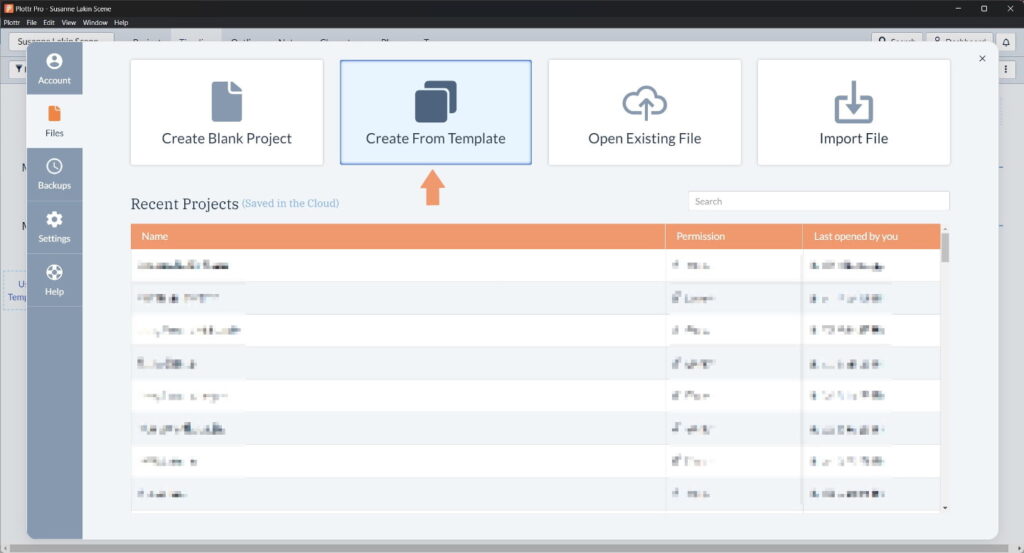
- Step 2: Select the Romance Beat Sheet template from the sidebar. Then click on Create New Project
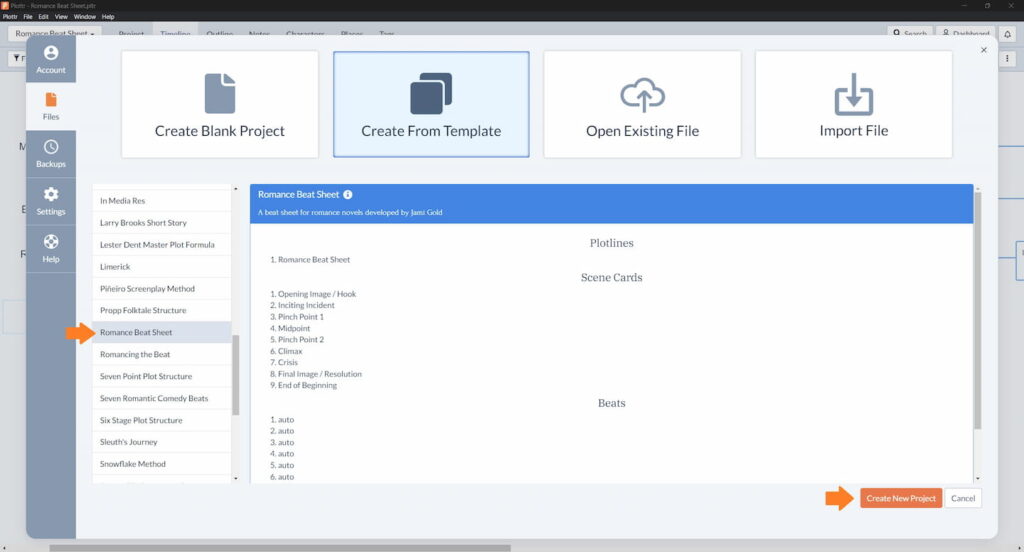
- Step 3: Give your project a name. The name will appear in your list of projects so you can return to it at any time
- Step 4: The template will open in Timeline view
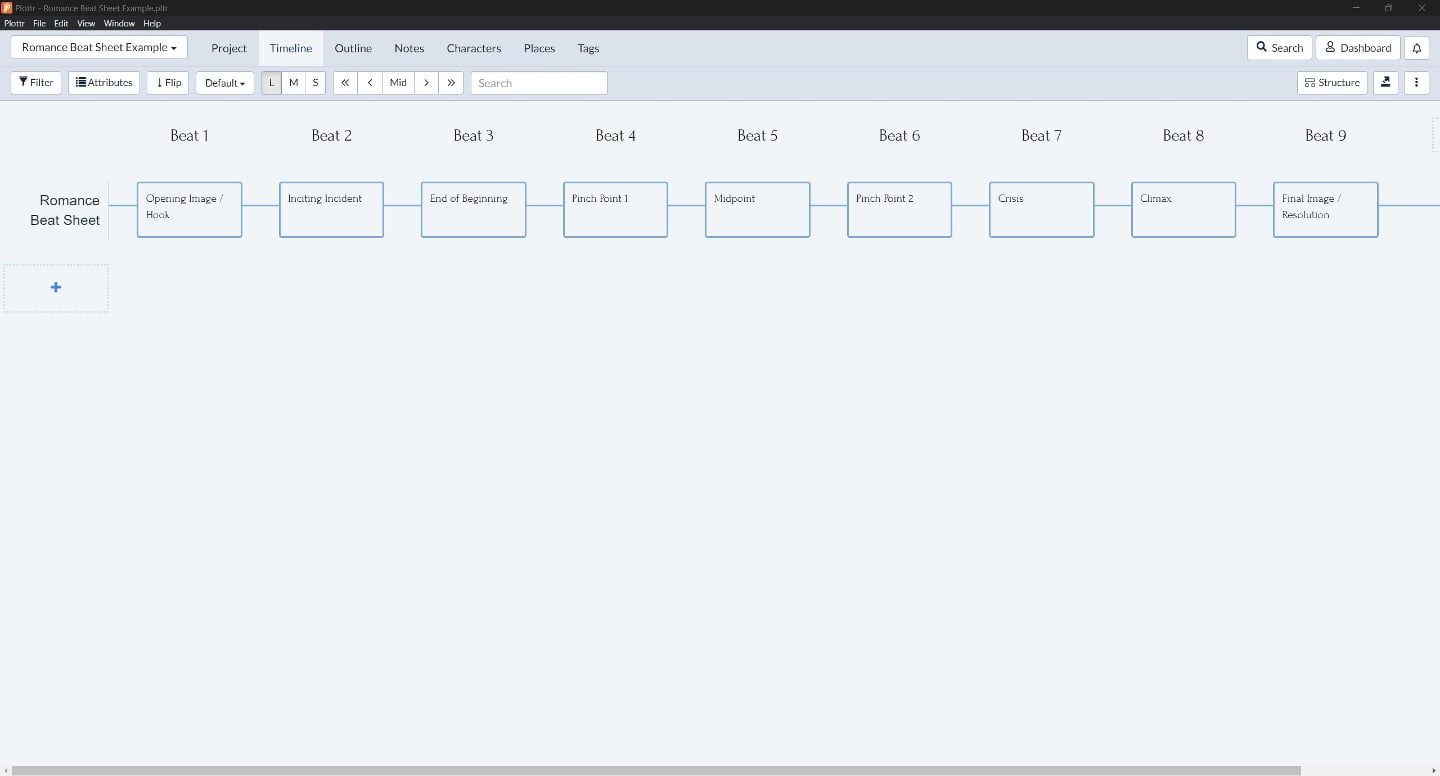
- Step 5: Open any scene card to start adding your ideas! You can save the guideline text to refer to, or delete and replace it
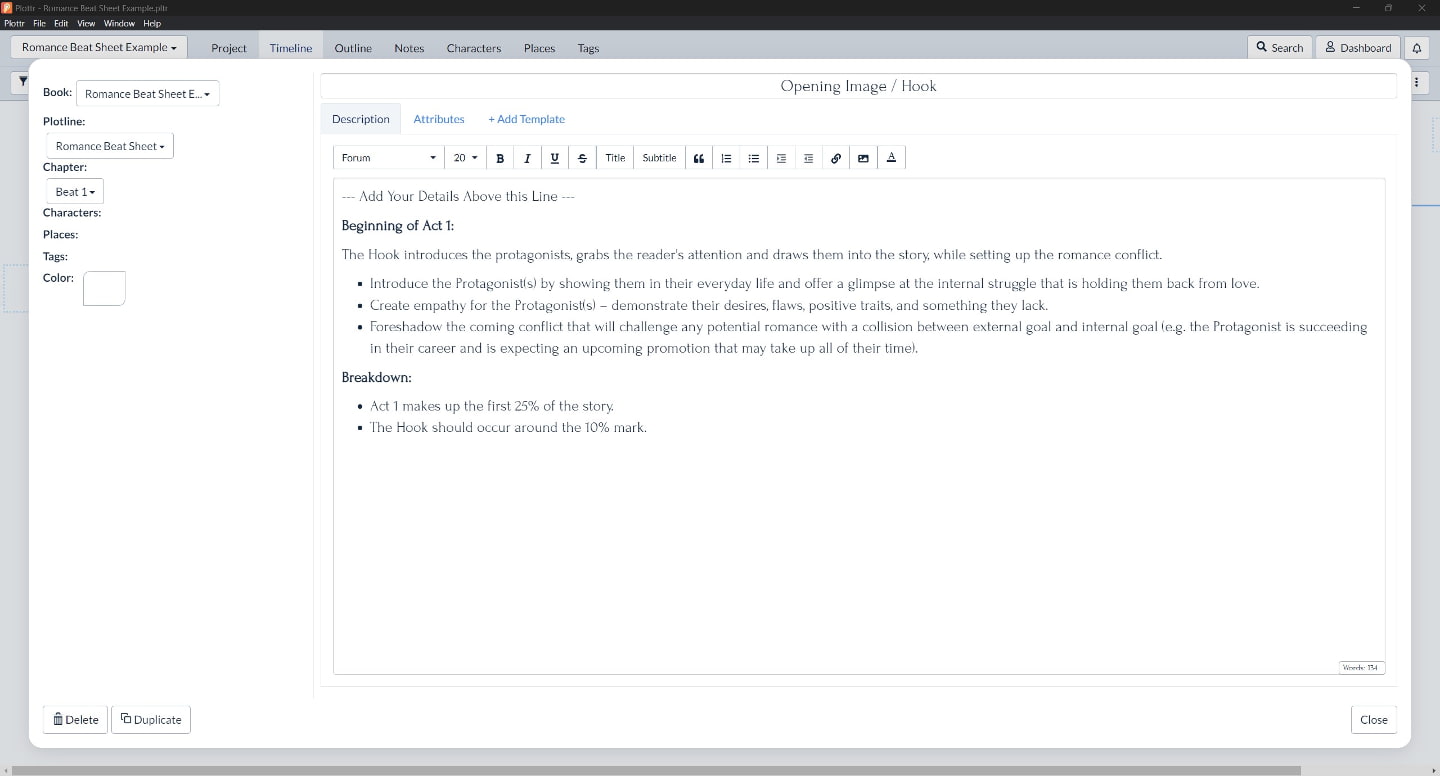
-OR-
In an existing timeline, hover over the plus button to add another plot line. On the left side of the box, choose Use Template. Select Romance Beat Sheet, and the template will appear in your timeline.
Plot templates in Plottr work great together. If you need a subplot or B-story, try:
You can learn more about popular plot structure types here.
Ready to Go from Enemies to Lovers with Plotting?
Try the Larry Brooks Short Story template now with a free Plottr trial. Or see Plottr plans and pricing. What’s your favorite romance read right now? Tell us in the comments!
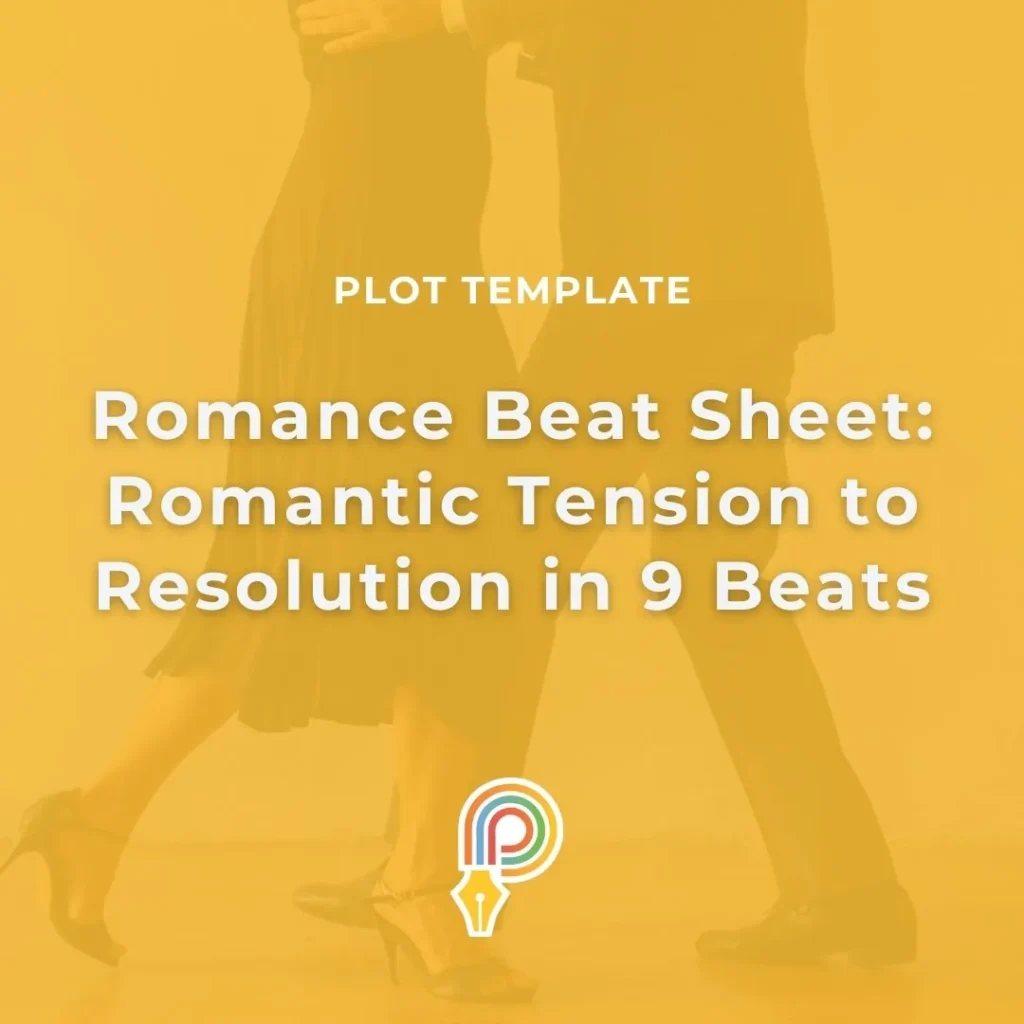

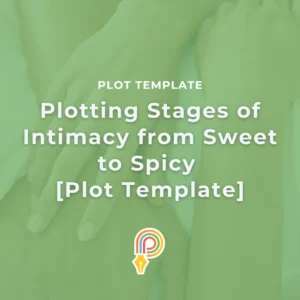
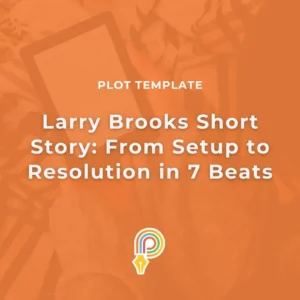
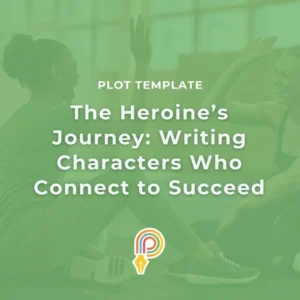

Comments